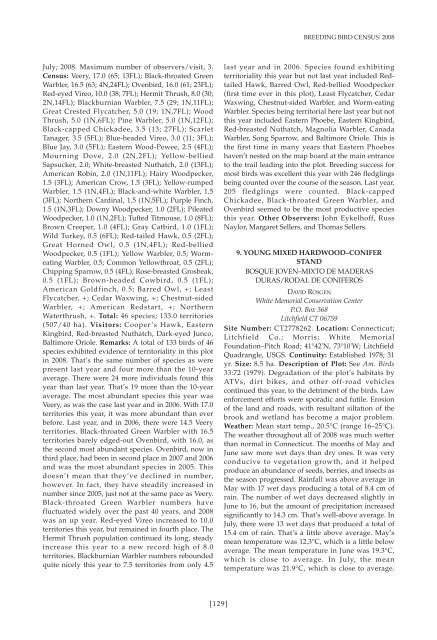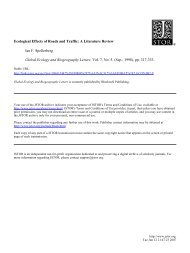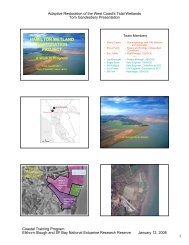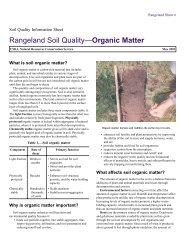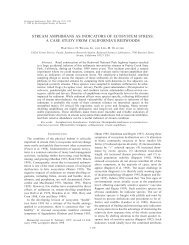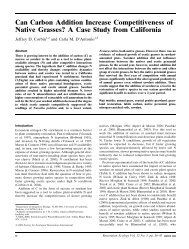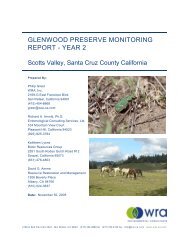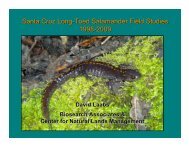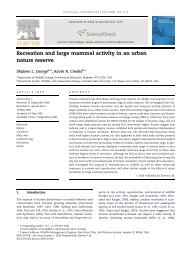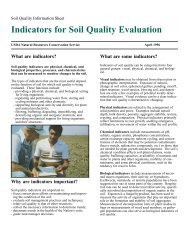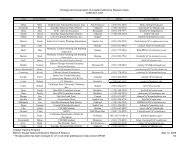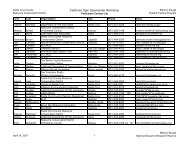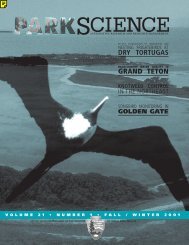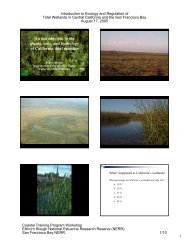BREEDING <strong>BIRD</strong> CENSUS: 2008Warbler, Common Yellowthroat, Summer Tanager.Other Observer: Norman Brunswig.6. MATURE MAPLE–BEECH–BIRCH FORESTBOSQUE MADURO DE ARCE–HAYA–ABEDULLAURA M. LEWISCherokee National Forest2800 N. Ocoee StreetCleveland TN 37312Site Number: TN2392102. Location: Tennessee;Monroe Co.; Whigg Ridge, Cherokee National Forest;35°19'36”N, 84°2'30”W; Big Junction Quadrangle,USGS. Continuity: Established 1992; 16 yr. Size: 10.2ha. Description of Plot: See J. Field Ornithol.64(Suppl.):57–58 (1993) and 66(Suppl.):63 (1995).Hemlock mortality (due to woolly adelgid infestation)continues. Weather: Mean start temp., 21.3°C (range12–36°C). Coverage: 18.4 h; 8 visits (4 sunrise, 4sunset); 29, 30 May; 4, 5, 25, 26 June; 6, 7 July; 2008.Census: Veery, 13.0 (51); Blue-headed Vireo, 9.5 (37);Ovenbird, 7.0 (27); Dark-eyed Junco, 6.0 (24); TuftedTitmouse, 1.5; White-breasted Nuthatch, 1.0;Blackburnian Warbler, 1.0; Downy Woodpecker, +;Carolina Chickadee, +. Total: 9 species; 39.0 territories(153/40 ha). Visitors: Common Raven, Winter Wren,Eastern Towhee. Remarks: Flyovers: Chimney Swift,Purple Martin, and Cedar Waxwing. OtherObservers: David F. Vogt and Hayden Wilson.Acknowledgments: We wish to acknowledge thefinancial and logistical support of the CherokeeNational Forest.7. UPLAND CHRISTMAS TREE FARMFINCAS DE ARBOLES DE NAVIDAD DE ALTURASELIZABETH W. BROOKS5540 Jericho Hill RoadAlfred Station NY 14803Site Number: NY2483108. Location: New York,Allegany Co., Andover; Kent Christmas Tree Farm;42°10'N, 77°50'W; Andover Quadrangle, USGS.Continuity: Established 1983; 26 yr. Size: 10.7 ha.Description of Plot: See Am. Birds 38:91(1984). Duringthe previous two years, all the Scotch pine trees in thestudy area were removed. Weather: Mean start temp.18.6°C (range 12.2–22.2°C). Coverage: 13.6 h; 8 visitsplus 1 woodcock survey (0 sunrise, 1 sunset); 12April; 2, 9, 16, 23, 30 June; 14, 23, 29 July; 2008.Census: Chipping Sparrow, 14.0 (52; 1N); SongSparrow, 13.0 (49; 6N,5FL); American Robin, 9.0 (34;1N,2FL); Yellow-rumped Warbler, 6.0 (22); FieldSparrow, 4.0 (15; 1N); Purple Finch, 4.0; CedarWaxwing, 3.5 (13; 1N); Eastern Towhee, 2.5 (1N);Mourning Dove, 2.0; Magnolia Warbler, 2.0; BrownheadedCowbird, 2.0 (females); American Goldfinch,2.0; Prairie Warbler, 1.0; Savannah Sparrow, 1.0;Indigo Bunting, 1.0; Bobolink, 0.5; Red-wingedBlackbird, 0.5. Total: 17 species; 68.0 territories(254/40 ha). Visitors: Sharp-shinned Hawk, BlackbilledCuckoo, Blue-headed Vireo, Red-eyed Vireo,Black-capped Chickadee, Red-breasted Nuthatch,House Wren, Gray Catbird, Brown Thrasher,Chestnut-sided Warbler, Common Yellowthroat.Remarks: The number of territories (68.0) was aboutaverage, but lower than in any of the previous eightyears. There were no new species recorded on thestudy area. American Woodcock was missing afterbeing recorded in 21 of the past 24 years. No nestswere found parasitized by cowbirds. Acknowledgments:Appreciation to Rick Walker and DennisSmith for weather data and to Tom and Kathy Kentfor their continued interest and permission to conductthe study on their land.8. CLIMAX HEMLOCK–WHITE PINE FORESTWITH TRANSITION HARDWOODSBOSQUE CLIMAX DE PICEA–PINO BLANCO ENTRANSICION A MADERAS DURASDAVID ROSGENWhite Memorial Conservation CenterP.O. Box 368Litchfield CT 06759Site Number: CT2765008. Location: Connecticut;Litchfield Co.; Litchfield; White MemorialFoundation–Catlin Woods; 41°43'N, 73°12'W;Litchfield Quadrangle, USGS. Continuity: Established1965; 42 yr. Size: 10.5 ha. Description of Plot: SeeAud. Field Notes 19:594–595 (1965), J. Field Ornithol.67(Suppl.):60 (1996), and Bird Populations 8:129–130(2007). The vegetation was resurveyed in 1990 and2004, but the results have not been published.Weather: Mean start temp., 20.7°C (range 11–28°C).The weather throughout all of 2008 was much wetterthan normal in Connecticut. The months of May andJune saw more wet days than dry ones. It was veryconducive to vegetation growth, and it helpedproduce an abundance of seeds, berries, and insects asthe season progressed. Rainfall was above average inMay with 17 wet days producing a total of 8.4 cm ofrain. The number of wet days decreased slightly inJune to 16, but the amount of precipitation increasedsignificantly to 14.3 cm. That’s well-above average. InJuly, there were 13 wet days that produced a total of15.4 cm of rain. That’s a little above average. May’smean temperature was 12.3°C, which is a little belowaverage. The mean temperature in June was 19.3°C,which is close to average. In July, the meantemperature was 21.9°C, which is close to average.Source: White Memorial Foundation’s weatherstation. Coverage: 28.0 h; 11 visits (0 sunrise, 4sunset); 7, 14, 21, 28 May; 5, 13, 25 June; 3, 10, 18, 28[128]
BREEDING <strong>BIRD</strong> CENSUS: 2008July; 2008. Maximum number of observers/visit, 3.Census: Veery, 17.0 (65; 13FL); Black-throated GreenWarbler, 16.5 (63; 4N,24FL); Ovenbird, 16.0 (61; 23FL);Red-eyed Vireo, 10.0 (38; 7FL); Hermit Thrush, 8.0 (30;2N,14FL); Blackburnian Warbler, 7.5 (29; 1N,11FL);Great Crested Flycatcher, 5.0 (19; 1N,7FL); WoodThrush, 5.0 (1N,6FL); Pine Warbler, 5.0 (1N,12FL);Black-capped Chickadee, 3.5 (13; 27FL); ScarletTanager, 3.5 (5FL); Blue-headed Vireo, 3.0 (11; 3FL);Blue Jay, 3.0 (5FL); Eastern Wood-Pewee, 2.5 (4FL);Mourning Dove, 2.0 (2N,2FL); Yellow-belliedSapsucker, 2.0; White-breasted Nuthatch, 2.0 (13FL);American Robin, 2.0 (1N,11FL); Hairy Woodpecker,1.5 (3FL); American Crow, 1.5 (3FL); Yellow-rumpedWarbler, 1.5 (1N,4FL); Black-and-white Warbler, 1.5(3FL); Northern Cardinal, 1.5 (1N,5FL); Purple Finch,1.5 (1N,3FL); Downy Woodpecker, 1.0 (2FL); PileatedWoodpecker, 1.0 (1N,2FL); Tufted Titmouse, 1.0 (8FL);Brown Creeper, 1.0 (4FL); Gray Catbird, 1.0 (1FL);Wild Turkey, 0.5 (6FL); Red-tailed Hawk, 0.5 (2FL);Great Horned Owl, 0.5 (1N,4FL); Red-belliedWoodpecker, 0.5 (1FL); Yellow Warbler, 0.5; WormeatingWarbler, 0.5; Common Yellowthroat, 0.5 (2FL);Chipping Sparrow, 0.5 (4FL); Rose-breasted Grosbeak,0.5 (1FL); Brown-headed Cowbird, 0.5 (1FL);American Goldfinch, 0.5; Barred Owl, +; LeastFlycatcher, +; Cedar Waxwing, +; Chestnut-sidedWarbler, +; American Redstart, +; NorthernWaterthrush, +. Total: 46 species; 133.0 territories(507/40 ha). Visitors: Cooper’s Hawk, EasternKingbird, Red-breasted Nuthatch, Dark-eyed Junco,Baltimore Oriole. Remarks: A total of 133 birds of 46species exhibited evidence of territoriality in this plotin 2008. That’s the same number of species as werepresent last year and four more than the 10-yearaverage. There were 24 more individuals found thisyear than last year. That’s 19 more than the 10-yearaverage. The most abundant species this year wasVeery, as was the case last year and in 2006. With 17.0territories this year, it was more abundant than everbefore. Last year, and in 2006, there were 14.5 Veeryterritories. Black-throated Green Warbler with 16.5territories barely edged-out Ovenbird, with 16.0, asthe second most abundant species. Ovenbird, now inthird place, had been in second place in 2007 and 2006and was the most abundant species in 2005. Thisdoesn’t mean that they’ve declined in number,however. In fact, they have steadily increased innumber since 2005, just not at the same pace as Veery.Black-throated Green Warbler numbers havefluctuated widely over the past 40 years, and 2008was an up year. Red-eyed Vireo increased to 10.0territories this year, but remained in fourth place. TheHermit Thrush population continued its long, steadyincrease this year to a new record high of 8.0territories. Blackburnian Warbler numbers reboundedquite nicely this year to 7.5 territories from only 4.5last year and in 2006. Species found exhibitingterritoriality this year but not last year included RedtailedHawk, Barred Owl, Red-bellied Woodpecker(first time ever in this plot), Least Flycatcher, CedarWaxwing, Chestnut-sided Warbler, and Worm-eatingWarbler. Species being territorial here last year but notthis year included Eastern Phoebe, Eastern Kingbird,Red-breasted Nuthatch, Magnolia Warbler, CanadaWarbler, Song Sparrow, and Baltimore Oriole. This isthe first time in many years that Eastern Phoebeshaven’t nested on the map board at the main entranceto the trail leading into the plot. Breeding success formost birds was excellent this year with 246 fledglingsbeing counted over the course of the season. Last year,205 fledglings were counted. Black-cappedChickadee, Black-throated Green Warbler, andOvenbird seemed to be the most productive speciesthis year. Other Observers: John Eykelhoff, RussNaylor, Margaret Sellers, and Thomas Sellers.9. YOUNG MIXED HARDWOOD–CONIFERSTANDBOSQUE JOVEN–MIXTO DE MADERASDURAS/RODAL DE CONIFEROSDAVID ROSGENWhite Memorial Conservation CenterP.O. Box 368Litchfield CT 06759Site Number: CT2778262. Location: Connecticut;Litchfield Co.; Morris; White MemorialFoundation–Pitch Road; 41°42'N, 73°10'W; LitchfieldQuadrangle, USGS. Continuity: Established 1978; 31yr. Size: 8.5 ha. Description of Plot: See Am. Birds33:72 (1979). Degradation of the plot’s habitats byATVs, dirt bikes, and other off-road vehiclescontinued this year, to the detriment of the birds. Lawenforcement efforts were sporadic and futile. Erosionof the land and roads, with resultant siltation of thebrook and wetland has become a major problem.Weather: Mean start temp., 20.5°C (range 16–25°C).The weather throughout all of 2008 was much wetterthan normal in Connecticut. The months of May andJune saw more wet days than dry ones. It was veryconducive to vegetation growth, and it helpedproduce an abundance of seeds, berries, and insects asthe season progressed. Rainfall was above average inMay with 17 wet days producing a total of 8.4 cm ofrain. The number of wet days decreased slightly inJune to 16, but the amount of precipitation increasedsignificantly to 14.3 cm. That’s well-above average. InJuly, there were 13 wet days that produced a total of15.4 cm of rain. That’s a little above average. May’smean temperature was 12.3°C, which is a little belowaverage. The mean temperature in June was 19.3°C,which is close to average. In July, the meantemperature was 21.9°C, which is close to average.[129]
- Page 1 and 2:
BIRD POPULATIONSA journal of global
- Page 3 and 4:
BIRD POPULATIONSA journal of global
- Page 6 and 7:
ROBERT L. WILKERSON AND RODNEY B. S
- Page 8 and 9:
ROBERT L. WILKERSON AND RODNEY B. S
- Page 10 and 11:
ROBERT L. WILKERSON AND RODNEY B. S
- Page 12 and 13:
ROBERT L. WILKERSON AND RODNEY B. S
- Page 14 and 15:
ROBERT L. WILKERSON AND RODNEY B. S
- Page 16 and 17:
ROBERT L. WILKERSON AND RODNEY B. S
- Page 18 and 19:
ROBERT L. WILKERSON AND RODNEY B. S
- Page 20 and 21:
ROBERT L. WILKERSON AND RODNEY B. S
- Page 22 and 23:
ROBERT L. WILKERSON AND RODNEY B. S
- Page 24 and 25:
ROBERT L. WILKERSON AND RODNEY B. S
- Page 26 and 27:
ROBERT L. WILKERSON AND RODNEY B. S
- Page 28 and 29:
ROBERT L. WILKERSON AND RODNEY B. S
- Page 30 and 31:
ROBERT L. WILKERSON AND RODNEY B. S
- Page 32 and 33:
ROBERT L. WILKERSON AND RODNEY B. S
- Page 34 and 35:
ROBERT L. WILKERSON AND RODNEY B. S
- Page 36 and 37:
ROBERT L. WILKERSON AND RODNEY B. S
- Page 38 and 39:
ROBERT L. WILKERSON AND RODNEY B. S
- Page 40 and 41:
NIRANJAN DAS AND SUJATA DEORIincluy
- Page 42 and 43:
NIRANJAN DAS AND SUJATA DEORIprovid
- Page 44 and 45:
NIRANJAN DAS AND SUJATA DEORIpopula
- Page 46 and 47:
NIRANJAN DAS AND SUJATA DEORITABLE
- Page 48 and 49:
NIRANJAN DAS AND SUJATA DEORITABLE
- Page 50 and 51:
NIRANJAN DAS AND SUJATA DEORITABLE
- Page 52 and 53:
NIRANJAN DAS AND SUJATA DEORITABLE
- Page 54 and 55:
NIRANJAN DAS AND SUJATA DEORITABLE
- Page 56 and 57:
NIRANJAN DAS AND SUJATA DEORITABLE
- Page 58 and 59:
Bird Populations 10:56-64© The Ins
- Page 60 and 61:
WETLAND BIRDS OF GHANAAvicennia afr
- Page 62 and 63:
WETLAND BIRDS OF GHANATABLE 1. Data
- Page 64 and 65:
WETLAND BIRDS OF GHANATABLE 2: Esti
- Page 66 and 67:
WETLAND BIRDS OF GHANAATTUQUAYEFIO,
- Page 68 and 69:
JANNIK HANSEN, LARS HOLST HANSEN, N
- Page 70 and 71:
JANNIK HANSEN, LARS HOLST HANSEN, N
- Page 72 and 73:
JANNIK HANSEN, LARS HOLST HANSEN, N
- Page 74 and 75:
JANNIK HANSEN, LARS HOLST HANSEN, N
- Page 76 and 77:
JANNIK HANSEN, LARS HOLST HANSEN, N
- Page 78 and 79:
JANNIK HANSEN, LARS HOLST HANSEN, N
- Page 80 and 81: JANNIK HANSEN, LARS HOLST HANSEN, N
- Page 82 and 83: JANNIK HANSEN, LARS HOLST HANSEN, N
- Page 84 and 85: JANNIK HANSEN, LARS HOLST HANSEN, N
- Page 86 and 87: JANNIK HANSEN, LARS HOLST HANSEN, N
- Page 88 and 89: JANNIK HANSEN, LARS HOLST HANSEN, N
- Page 90 and 91: BIRD POPULATIONSA journal of global
- Page 92 and 93: Bird Populations 10:90-109© The In
- Page 94 and 95: DAVID J. ZIOLKOWSKI JR., KEITH L. P
- Page 96 and 97: DAVID J. ZIOLKOWSKI JR., KEITH L. P
- Page 98 and 99: DAVID J. ZIOLKOWSKI JR., KEITH L. P
- Page 100 and 101: DAVID J. ZIOLKOWSKI JR., KEITH L. P
- Page 102 and 103: DAVID J. ZIOLKOWSKI JR., KEITH L. P
- Page 104 and 105: DAVID J. ZIOLKOWSKI JR., KEITH L. P
- Page 106 and 107: DAVID J. ZIOLKOWSKI JR., KEITH L. P
- Page 108 and 109: DAVID J. ZIOLKOWSKI JR., KEITH L. P
- Page 110 and 111: DAVID J. ZIOLKOWSKI JR., KEITH L. P
- Page 112 and 113: Bird Populations 10:110-113© The I
- Page 114 and 115: THE 2007 AND 2008 NORTH AMERICAN BR
- Page 116 and 117: Bird Populations 10:114-124© The I
- Page 118 and 119: BREEDING BIRD CENSUS: 2007on the pl
- Page 120 and 121: BREEDING BIRD CENSUS: 2007May, with
- Page 122 and 123: BREEDING BIRD CENSUS: 2007Remarks:
- Page 124 and 125: BREEDING BIRD CENSUS: 200717. PITCH
- Page 126 and 127: BREEDING BIRD CENSUS: 2007+; Wester
- Page 128 and 129: BREEDING BIRD CENSUS: 2008gray Gnat
- Page 132 and 133: BREEDING BIRD CENSUS: 2008Source: W
- Page 134 and 135: BREEDING BIRD CENSUS: 2008Spotted T
- Page 136 and 137: BREEDING BIRD CENSUS: 2008precipita
- Page 138 and 139: Bird Populations 10© The Institute
- Page 140 and 141: IS AVIAN BREEDING SUCCESS WEATHERIN
- Page 142 and 143: IS AVIAN BREEDING SUCCESS WEATHERIN
- Page 144 and 145: DAVE LEECH AND CARL BARIMOREFlycatc
- Page 146 and 147: Bird Populations 10:143-145Reprinte
- Page 148 and 149: WOODPIGEON JOINS THE GARDEN PREMIER
- Page 150 and 151: CHANGING THE GUARD AT UK BIRDTABLES
- Page 152 and 153: Bird Populations is an entirely ele
- Page 154: BIRD POPULATIONSA journal of global


